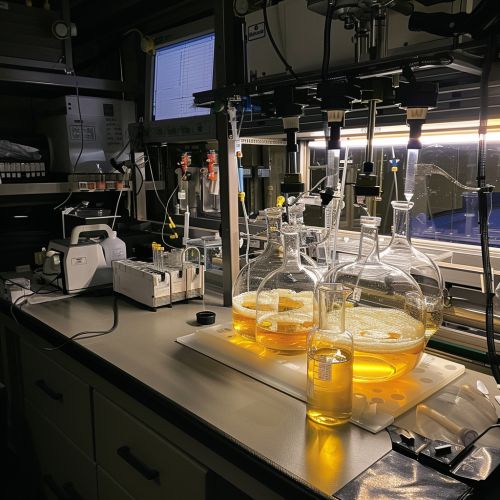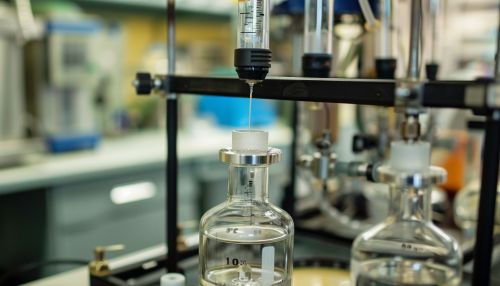Ester Hydrolysis
Ester Hydrolysis
Ester hydrolysis is a chemical reaction in which an ester is converted into its constituent alcohol and carboxylic acid. This reaction is an important process in both organic chemistry and biochemistry, playing a crucial role in various metabolic pathways and industrial applications.


Mechanism of Ester Hydrolysis
Ester hydrolysis can proceed via two primary mechanisms: acid-catalyzed hydrolysis and base-catalyzed hydrolysis (saponification).
Acid-Catalyzed Hydrolysis
In acid-catalyzed hydrolysis, the ester is treated with a strong acid, such as hydrochloric acid or sulfuric acid, which acts as a catalyst. The reaction mechanism involves several steps:
1. **Protonation of the Carbonyl Oxygen:** The carbonyl oxygen of the ester is protonated by the acid, increasing the electrophilicity of the carbonyl carbon. 2. **Nucleophilic Attack:** Water, acting as a nucleophile, attacks the carbonyl carbon, forming a tetrahedral intermediate. 3. **Proton Transfer:** A proton transfer occurs within the intermediate, leading to the formation of a protonated alcohol and a protonated carboxylic acid. 4. **Deprotonation:** The protonated carboxylic acid loses a proton to yield the final carboxylic acid product.
The overall reaction can be summarized as: \[ \text{RCOOR'} + \text{H}_2\text{O} \rightarrow \text{RCOOH} + \text{R'OH} \]
Base-Catalyzed Hydrolysis (Saponification)
In base-catalyzed hydrolysis, also known as saponification, the ester is treated with a strong base, such as sodium hydroxide or potassium hydroxide. The mechanism involves the following steps:
1. **Nucleophilic Attack:** The hydroxide ion (OH⁻) attacks the carbonyl carbon of the ester, forming a tetrahedral intermediate. 2. **Collapse of the Intermediate:** The intermediate collapses, expelling the alkoxide ion (R'O⁻) and forming a carboxylate ion (RCOO⁻). 3. **Proton Transfer:** The alkoxide ion abstracts a proton from water, yielding the alcohol (R'OH) and regenerating the hydroxide ion.
The overall reaction can be summarized as: \[ \text{RCOOR'} + \text{OH}^- \rightarrow \text{RCOO}^- + \text{R'OH} \]
Factors Affecting Ester Hydrolysis
Several factors influence the rate and efficiency of ester hydrolysis, including:
- **Nature of the Ester:** The reactivity of the ester depends on the electronic and steric properties of the substituents attached to the carbonyl carbon.
- **Type of Catalyst:** The choice of acid or base catalyst significantly affects the reaction rate.
- **Temperature:** Higher temperatures generally increase the reaction rate by providing the necessary activation energy.
- **Solvent:** The solvent can influence the reaction by stabilizing intermediates or transition states.
Applications of Ester Hydrolysis
Ester hydrolysis has numerous applications in both industrial and biological contexts:
Industrial Applications
- **Soap Production:** Saponification of fats and oils (triglycerides) is a key step in soap manufacturing.
- **Polymer Degradation:** Hydrolysis of ester linkages in polyesters is used in recycling and biodegradation processes.
- **Flavor and Fragrance Industry:** Controlled hydrolysis of esters is employed to release specific alcohols and acids that contribute to flavors and fragrances.
Biological Applications
- **Metabolism:** Ester hydrolysis is involved in the breakdown of lipids, such as triglycerides, into fatty acids and glycerol.
- **Drug Metabolism:** Ester-containing drugs undergo hydrolysis to release active pharmaceutical ingredients or metabolites.
- **Signal Transduction:** Hydrolysis of phosphoesters in nucleotides and phospholipids plays a role in cellular signaling pathways.
Experimental Techniques
Various experimental techniques are used to study and optimize ester hydrolysis reactions:
- **Spectroscopy:** Techniques such as NMR and IR spectroscopy are used to monitor the progress of the reaction and identify intermediates.
- **Chromatography:** High-performance liquid chromatography (HPLC) and gas chromatography (GC) are employed to separate and quantify the reaction products.
- **Kinetic Studies:** Reaction kinetics are studied to determine the rate constants and activation energies, providing insights into the reaction mechanism.
Environmental and Safety Considerations
Ester hydrolysis reactions, especially those involving strong acids or bases, require careful handling and disposal of reagents and by-products. Environmental and safety considerations include:
- **Waste Management:** Proper disposal of acidic or basic waste to prevent environmental contamination.
- **Personal Protective Equipment (PPE):** Use of appropriate PPE, such as gloves and goggles, to protect against chemical exposure.
- **Ventilation:** Conducting reactions in well-ventilated areas or fume hoods to avoid inhalation of hazardous fumes.
